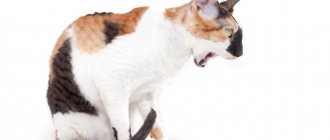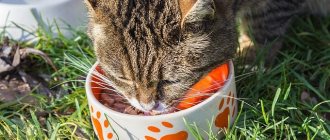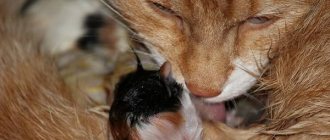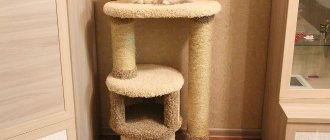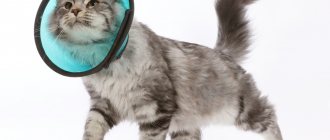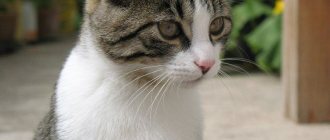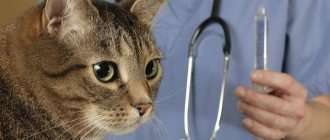Description and characteristics
"Bifidumbacterin" is a probiotic consisting of bifidobacteria and resists a wide range of pathogenic and opportunistic microorganisms of the gastrointestinal tract. It belongs to the means that normalize the intestinal microflora.
The drug can be produced in different forms:
- bagged powder;
- dry mass in bottles;
- dry mass in ampoules;
- capsules;
- suppositories for vaginal or rectal use.
For each case, the most appropriate form is selected, including a lot depending on the character of the cat.
Causes of pancreatitis
Obesity, a sudden change in diet, or an unusual food product can provoke inflammation of the pancreas. Food from the table is especially dangerous - fatty food containing salt and spices. A piece of raw smoked sausage can kill a cat with sensitive digestion.
- Systemic diseases:
- diabetes mellitus: increased levels of fats in the blood damage the pancreas;
- oncology: increased calcium levels in the blood;
- toxoplasmosis;
- infectious peritonitis;
- diseases of the liver and gall bladder (cholecystitis).
- Use of medications.
Iatrogenic pancreatitis can be caused by:
- diuretics (Furosemide);
- antibiotics (Tetracycline);
- sulfonamides;
- hormonal drugs.
Paracetamol is dangerous for cats.
Mold, expired foods, especially meat, rancid fat - all this can be found in anyone’s refrigerator, unlike arsenic and mercury. Dangerous at home:
- pesticides;
- fertilizers;
- alcohol;
- organophosphorus compounds;
- any household chemicals.
- Genetic predisposition.
Pathology is often recorded in Siamese cats and Orientals.
The cause of pancreatitis may remain a mystery, although most often the disease is associated with a dietary factor.
Chemical composition of the drug
“Bifidumbacterin” consists of dry biomass of living bacteria of the Bifidobacterium bifidum strain No. 1 and a growing medium that includes lactose. Each dose of the drug contains 10^7 or 10^8 microorganisms. There are 5 doses in a bottle, bag or ampoule, and one dose in a capsule and in a suppository.
In “Bifidumbacterin Forte” the dry mass of bifidobacteria is immobilized on stone activated carbon. This version of the drug also contains lactose.
Find out also about the use of the antibiotic "Amoxoil retard" for cats.
Diagnostics
Pancreatitis is diagnosed based on history, clinical picture, and exclusion of other possible diagnoses.
Images are necessary to exclude a foreign body in the intestinal loops. X-rays can reveal effusion into the abdominal cavity and coprostasis.
An ultrasound allows you to clearly see the abdominal organs - the liver, intestines and stomach, and the pancreas itself. In a healthy cat it can be difficult to visualize; with pancreatitis, it enlarges and changes color (echogenicity). Ultrasound remains the main way to confirm pancreatitis in a cat.
Blood is taken from a sick animal for a general clinical analysis (cellular formula) and a detailed biochemical profile. This data is needed not only for diagnosing pancreatitis, but also for identifying concomitant diseases (renal failure, diabetes, viral infection).
An increase in amylase and lipase, contrary to popular myth, is not a specific sign of pancreatitis. These enzymes will also be elevated in case of intestinal foreign body or enteritis, and in case of inflammation of the pancreas they may be within normal limits. A test for pancreatitis was developed in the USA - determining the level of pancreatic lipase in serum, but it is not available in most veterinary clinics in Russia.
If conservative treatment fails, doctors may resort to open abdominal surgery - exploratory laparotomy. The surgeon excludes a foreign body of the intestine (blockage of the digestive tract is accompanied by similar symptoms) and evaluates the condition of the pancreas.
Sometimes a tumor on or near the pancreas can be detected only in this way. The doctor notes the presence of cysts, abscesses, effusion into the abdominal cavity, checks the stomach and intestines to see if there is a perforated ulcer.
A biopsy of the gland is rarely taken, since histological examination data are of scientific rather than practical significance. But novocaine blockade of the pancreas and mesentery of the small intestine has a good therapeutic effect, and after surgery the animals stop vomiting.
Is it possible to give "Bifidumbacterin"
“Bifidumbacterin” refers to drugs that are recommended to be kept in the first aid kit for cats and kittens at all times.
Cats
Pets should be given “Bifidumbacterin” in case of diarrhea, gastrointestinal problems, taking antibiotics, or vomiting. All of these symptoms can be signs of a serious illness, especially if the animal is not vaccinated. If they are accompanied by fever, lethargy, blood in the stool, or discharge from the nose and eyes, the cat should be seen by a doctor.
Every cat first aid kit should have a remedy for diarrhea and sudden vomiting in cats; Bifidumbacterin is perfect for these purposes.
Exotic breed cats have sensitive digestion, and sometimes problems begin when switching to another food. Intestinal disorders in an animal can be caused by stress, poisoning, invasive diseases, poor-quality food, infections and chronic gastrointestinal diseases, pancreatitis.
Important! If you give the drug for 2 days and the symptoms do not go away, the animal needs a medical examination.
Kittens
A kitten often experiences intestinal problems and diarrhea when switching from mother's milk to another food. This transition should be carried out gradually. A sudden change of food is stressful for the microflora of kittens and the administration of Bifidobacterin will help them digest new food.
The use of Bifidobacterin as a medicine will help to improve the kitten's stool as quickly as possible.
Nutritional supplements, pre- and probiotics
Fortiflora is a probiotic supplement for the diet of cats of any age. The laxative is mixed with the food. It helps not only against constipation, but also optimizes the entire functioning of the gastrointestinal tract.
The composition has a pleasant taste and smell, actively restores the internal intestinal microflora. The duration of the course of treatment is 2 weeks, you need to take 1 sachet per day.
The laxative effect of the drug Vetelakt is combined with the activation of intestinal motility and a decrease in the proportion of ammonia. This medicinal syrup is based on the probiotic lactulose. For each animal, the dosage is determined individually - 0.1 ml of product per 1 kg of live weight.
The new generation prebiotic Viyo accelerates the proliferation of beneficial microflora in the intestines of the domestic cat. This optimizes digestion and prevents constipation. The product looks like a fragrant broth; 1 sachet is enough for an adult cat for 24 hours.
The composition of Viyo should be chosen taking into account the age of your pet. There are several varieties on sale:
- For animals from one to 7 years old.
- For babies (kittens 1–12 months).
- For older cats over 7 years old.
Interesting! If a cat has pancreatitis, many medications are contraindicated for it. In this case, the homeopathic remedy Veracol will help out. The drug will not only improve intestinal function, but also prevent the development of inflammation.
Instructions for use and dosage
To treat pets, it is better to use this medication in powder form. One bottle of powder is a single dose for an adult cat. Before use, the powder must be diluted with a small amount of boiled water at room temperature. Five teaspoons is enough to dissolve the drug.
- First, add a little water to the bottle with the powder.
- Then the bottle is vigorously shaken until the drug is completely dissolved.
- Then add the remaining liquid.
Important! The powder diluted with water should be used within 5 hours - then it becomes unusable. Also, it cannot be diluted with water above +40°C.
It is recommended to give the resulting solution to kittens using a pipette. Adult cats are usually given it using a syringe or simply given as a drink. All cats like the components of Bifidumbacterin, so the drug can be given as a drink . Pets will lap it up with pleasure.
Kittens up to 6 months are given 1/2 bottle. The drug is taken 2-3 times a day; usually in the morning, afternoon and evening. Duration of treatment is 1–3 days. You can give bifidobacteria to a kitten from 2 weeks of age.
The dosage is calculated taking into account the weight of the animal
Indications for taking Bifidumbacterin in childhood
"Bifidumbacterin" can be prescribed for the following conditions:
- dysbiosis of the gastrointestinal tract;
- various intestinal pathologies, in particular salmonellosis, rotavirus infection, etc.;
- toxic and intestinal infections of unknown origin;
- disturbance in the absorption function of the gastrointestinal tract;
- for chronic constipation;
- allergic reactions that can provoke the development of dysbiosis.
"Bifidumbacterin" is recommended for use by newborns receiving artificial formula or being fed donor breast milk. The drug promotes the formation of the necessary intestinal microflora, significantly reducing the severity of intestinal colic. Reviews from women who have used the drug in this particular direction confirm its effectiveness.
It is necessary to drink "Bifidumbacterin" either before meals - about thirty minutes - or at the same time.
- Capsules should be swallowed whole with clean water or any fermented milk product.
- Before use, the dose of powder/lyophilisate is diluted with cold boiled water (volume 30.0...50.0 ml). You can also use milk, infant formula and fermented milk drinks.
How to give the drug? For gastrointestinal infections and food poisoning, the probiotic is prescribed according to the following scheme:
- five to ten therapeutic doses twice a day;
- Duration of therapy – 7…10 days.
In severe cases of pathology, treatment can be extended to two to four weeks.
Taking a probiotic for dysbiosis:
- ten doses 2…3 times within 24 hours;
- duration of treatment - 5...15 days (maximum duration of therapy - two months).
Average doses of Bifidumbacterin in the treatment of other diseases:
- from birth to one year - five doses 2...3 times every 24 hours;
- one year – seven years – five doses 3…4 times within 24 hours;
- over seven years – ten doses 2…3 times every 24 hours.
https://www.youtube.com/watch?v=PpkBk8KM8XQ
The drug can be used for preventive purposes. The dosage will depend on the age of the child:
- babies up to one year - 2.5 doses no more than twice a day;
- over a year - five to ten doses up to two times a day.
The duration of prophylactic use should not exceed 15 days. Courses can be held 2…3 times a year.
Liquid dosage:
- babies up to one year - 0.5 ml twice a day;
- one year….twelve years – 0.5…1 ml up to three times a day;
- over twelve years old – 1…2 ml up to three times a day.
The duration of the course is two ... three weeks. In some cases (at the discretion of the attending physician), the duration of therapy can be increased to two months.
Quite often, the drug “Bifidumbacterin” is prescribed simultaneously with taking antibiotics. In this case, the drug is taken three hours after the antibiotic.
"Bifidumbacterin forte" differs from other forms of the drug. Here the bacteria are artificially grown colonies. After entering the child’s body, they begin active reproduction, suppressing all pathogenic microflora
This form of the drug is taken with meals.
- If the child is old enough, he can take capsules.
- For children, the powder of the drug is used, which must be diluted in water or milk (30...50 ml).
Standard dosage:
- babies up to one year – a package 2…3 times a day;
- one year...twelve years – sachet/capsule up to four times a day;
- over twelve years old – two sachets/capsules up to three times a day.
Increased doses:
- one year... twelve years – five sachets/capsules three times a day.
An increased dosage of the drug can only be used in children who are already one year old.
Cost and analogues of the drug
The price of “Bifidumbacterin” depends on the shape, number of pieces in the package and manufacturer. A package of 10 bottles from a domestic manufacturer can cost only 72 rubles.
If the pharmacy does not have Bifidumbacterin in stock, you can purchase the following similar products instead:
- "Bifinorm";
- "Lactobacterin";
- "Baktisubtil";
- "Probifor";
- "Lactobifadol";
- "Bififol".
Diet
To stop the formation of digestive juices in the pancreas, as well as in connection with indomitable vomiting, a starvation diet is prescribed.
The cat should not fast for more than 1-2 days. If food is not supplied for more than 3 days, it causes liver lipidosis.
Early feeding supports the function of the digestive tract. If your pet refuses to eat, your doctor may install a feeding tube for your cat.
The main principle of feeding is little and often. If the pet drinks water, immediately try introducing liquid food. Food should be easily digestible and not greasy. It is convenient to use an industrial therapeutic diet:
Canned food can be diluted with water to the desired consistency. If the owners adhere to feeding homemade food, prepare rice with a slimy consistency, mixing it with lean boiled meat (beef). Fractional feeding is left for a long period, returning to double feeding and portion size gradually.
Storage conditions
"Bifidumbacterin" should be stored in a dry and dark place, out of reach of children . The recommended temperature should be no more than +10°C. The shelf life is no more than 1 year from the date of production. It is indicated on the packaging. After the specified storage period, use of the drug is prohibited.
Did you know? Bifidobacteria in a healthy kitten and other young mammals make up 80–90% of the total intestinal microflora.
Transportation of this medication must also be carried out at a temperature no higher than +10°C, but transportation up to +20°C is allowed for no more than 10 days.
Suppositories and enemas
One of the most reliable ways to relieve constipation in a domestic cat is an enema. The filler can be:
- slightly warmed water;
- laundry soap solution;
- medicinal formulations with lactulose (up to 10 g);
- vegetable oil (up to 10 g).
The fluid is carefully injected into the rectum with a rubber catheter. It is important to carry out the procedure slowly so as not to provoke vomiting in the animal. For a kitten it is better to use a pipette. As a rule, 2-3 procedures are enough to get results.
Using rectal suppositories to relieve constipation in a cat will require a lot of effort and patience from the animal owner. Functional constipation is treated with glycerin suppositories or Bisacodyl. A suppository (from 0.5 to 10 mg) is inserted into the anus, the animal must be held in your arms for several minutes.
Prevention of pancreatitis in cats
Measures to prevent inflammatory processes in the digestive gland include several basic rules. By adhering to them, the animal owner will be able to preserve the health of his pet.
It is recommended to regularly conduct preventive examinations at a veterinary clinic to prevent possible pathologies. You should not feed your animal food from your table, or feed large amounts of dairy products high in calcium.
When choosing dry cat food, it is important to carefully study the composition and production date. It is not recommended to trust cheap advertised feeds, as they contain a large amount of harmful substances and a minimum of useful ones.
If an animal has a history of digestive problems, it is necessary to closely monitor its condition and, if its health worsens, be sure to contact a veterinary clinic without self-medicating.
In addition, most owners of domestic cats often use human medications for treatment, which can not only aggravate the developing pathological process, but also harm the animal’s body.
Treatment regimen at home and in the clinic
For pancreatitis in cats, symptoms and treatment depend on many individual factors. It is imperative to take into account the causes of the disease, the severity of its course, the age of the animal, the presence of concomitant diseases and many other factors. Therefore, treatment methods are selected strictly individually.
Preventive examinations are an important factor in preventing disease
Drug treatment consists of prescribing the following drugs:
- infusion is used to combat signs of dehydration (ringer solution, saline solution, dextran);
- antispasmodics and painkillers (no-shpa, papaverine, baralgin, spazgan);
- to maintain heart activity, cardiac medications (cordiamin, camphor);
- for frequent vomiting, antiemetic drugs (maropitant, cerucal, chlorpromazine, metoclopramide);
- in the acute stage of the disease in order to reduce the level of digestive enzymes gordox;
- as enzymes pancreatin;
- animals that are exhausted and show obvious signs of anorexia are fed through a tube and prescribed drugs that increase appetite (mirtazapine);
- in very severe cases, complicated by possible concomitant diseases, if indicated, a transfusion of blood or its components may be performed;
- if there is a threat of septic conditions, then antibacterial therapy must be carried out;
- if foci of necrotic changes are detected in the tissues of the pancreas, surgical intervention is indicated to remove them and restore the vital functions of the organ;
- in the future, in order to support and strengthen the weakened body, the drug ligfol is prescribed.
The sick animal begins to lose weight, and it can lead to anorexia.
Pancreatin for cats: instructions for use
Many pet owners often wonder: is it possible to give pancreatin to a cat? The answer of any practicing veterinarian will be unequivocal: yes, definitely. A cat that has had inflammation of the gland needs pancreatin so as not to burden the already damaged pancreas. In addition, cat saliva does not contain amylase, unlike many other representatives of the animal world, so plant foods can only be digested in semi-prepared form.
Symptoms of pancreatic inflammation
Pancreatitis is divided into acute and chronic. Moreover, in the case of acute pancreatitis, the clinical picture will be much more pronounced than in the chronic form of the disease.
The clinical picture of acute pancreatitis is much brighter than that of the chronic form
Acute pancreatitis
The characteristic signs of acute pancreatitis appear quite suddenly and develop rapidly. This often occurs against the background of concomitant inflammatory diseases of the digestive system and other internal organs.
Pancreatitis in a cat in the acute phase is accompanied by the following symptoms:
- disruption of the gastrointestinal tract - dyspepsia (bloating, a feeling of heaviness in the stomach, rapid satiety), periodically occurring severe upset, and in the stool, which has a sour, unpleasant odor, pieces of undigested food are visible. Chronic constipation is also typical;
- vomiting is a clear sign of an acute form of the disease;
- clear evidence of severe dehydration of the animal’s body: the fur becomes brittle and dull, pronounced atony, the skin and mucous membranes are dry;
- the animal behaves restlessly, screams loudly and does not allow you to touch its very painful stomach;
- the abdomen is hard on palpation;
- often in the acute stage the body temperature rises;
- mucous membranes often acquire a yellowish tint;
- there is no appetite, the cat practically stops eating, becomes exhausted, and in severe cases anorexia develops;
- a sick animal avoids communication, apathy and lethargy appear, often the cat tries to find a secluded corner where it will not be disturbed;
- breathing quickens, shortness of breath develops, and with severe and rapid development of the disease, feline pancreatitis leads to the fact that the animal falls into a lethargic sleep.
Enzymes for cats: preparations
Enzyme products for cats typically consist of enzymes artificially obtained from plants, fungi, or the pancreas of animals (usually pigs).
• Plant enzymes can act both in the stomach and intestines. As a rule, they are prescribed and used for digestive problems unrelated to pancreatic dysfunction. Plant proteins are contraindicated for asthma and allergies to these plants.
Plant enzymes include: betaine (a catalyst from beets that breaks down proteins and fats), bromelain (a protease from pineapple), nigedase (a lipase from nigella damascene seeds), papain (a protease from papaya), cellulase (an enzyme that breaks down cellulose from wheat germ ).
• Fungal enzymes are similar in their actions to plant enzymes, but they are dangerous for cats with weakened immune systems and can increase fermentation processes in the intestines. These enzymes are practically not administered to animals.
Fungal enzymes: orase (lipase, amylase, protease and maltase from the fungus aspergillus), solizym (lipase from the penicillin fungus).
• Animal enzymes are broken down in the stomach, so they are usually packaged in capsules so they can pass into the intestines. These enzymes most closely correspond to the enzymes that the cat produces on its own; based on this, they are prescribed for various pancreatic dysfunctions.
The animal enzyme is pancreatin (lipase, amylase, trypsin and chymotrypsin from animal pancreas). In most cases, pancreatin is obtained from the pancreas of pigs, so it is not recommended for cats with a pork allergy.
Composition and principle of operation
The probiotic Bifidumbacterin restores the protective functions of the intestines and has an antiallergic effect.
The medicine contains bifidobacteria bifidum, which normalize the intestinal microflora, destroy pathogenic and conditionally pathogenic microorganisms, and at the same time, normalize the functioning of the gastrointestinal tract, prevent complications of intestinal pathologies and restore impaired enteral synthesis of many vitamins and other substances. The drug is sold in the form of tablets, powder and suppositories. For each case, the most suitable dosage form is selected. If it is easy for cats to swallow tablets, then treatment with tableted “Bifidumbacterin” is quite possible. For the rest, the probiotic can be prescribed in powder. It is worth noting that the pharmaceutical product in question is absolutely safe for kittens, since it does not contain chemical additives.
Possible complications
Pancreatitis in a cat and its treatment depend on many factors: the degree of neglect of the disease, the reasons that caused it, the timing of detection of the disease, the presence of concomitant diseases. Therefore, it is possible to say unambiguously how effective the treatment will be only in each individual case.
It is also very important to use medications prescribed by a specialist, in strictly prescribed dosages and in accordance with the instructions. Following these rules will help save your pet's life.
The use of forte drugs for the stomach
- 1 Drugs to normalize the functioning of the stomach 1.1 “Hilak Forte” 1.1.1 Pharmacodynamics
- 1.1.2 Pharmacokinetics
- 1.1.3 Indications
- 1.1.4 Contraindications
- 1.1.5 Dosage
- 1.1.6 Overdose
- 1.1.7 Side effects
- 1.1.8 Drug interactions
- 1.1.9 Newborns and adult children
- 1.1.10 Pregnancy and lactation
- 1.1.11 Important points
- 1.2.1 Mechanism of action
- 1.3.1 Pharmacodynamics
Improper, unbalanced nutrition, snacks on the go, constant stress and a sedentary lifestyle provoke disturbances in the functioning of the gastrointestinal tract. As a result, various diseases develop. To stabilize the functions and functioning of the intestines, a wide selection of special medications are offered that are endowed with the ability to restore and improve digestion. We are talking about a group of forte drugs: Mezim, Hilak, Gaviscon.
Medicines to normalize stomach function
Digestion is disrupted when the secretory function in the gastrointestinal tract organs responsible for the production of enzymes fails. To improve the functioning of the digestive system, you need to drink enzyme preparations. They eliminate unpleasant symptoms, restore gastrointestinal functions, and relieve pain. Medicines are prescribed to patients of different age categories with various digestive dysfunctions.
Return to contents
"Hilak Forte"
A special feature of the medicine is the presence of beneficial bacteria in the active formula, which stimulate the growth of healthy intestinal flora. Available in liquid form - drops for oral use. Often prescribed to treat constipation and diarrhea.
Return to ContentsReturn to ContentsReturn to Contents
Pharmacodynamics
The substrate of metabolic products included in the active formula of the drug helps to stabilize and balance the healthy microflora of the gastrointestinal tract, which allows the restoration of mucous membranes. Auxiliary ingredients help regulate acid production, regardless of its level in the digestive juice. When restored biologically, the deficiency of vitamins B and K begins to be compensated.
The presence of short-chain fatty acids in the drops restores the water-electrolyte balance and the regenerative function of the cells lining the walls of small vessels, which improves blood flow and blood supply to the gastrointestinal tract. Taking drops in the first year of life allows you to quickly remove salmonella from bacterial enteritis in infants. This is helped by the growth of anaerobic acidophilic microflora, which inhibits pathogenic bacteria.
Return to ContentsReturn to ContentsReturn to Contents
Pharmacokinetics
Hilak Forte drops are not absorbed into the bloodstream and therefore do not have a systemic effect. The drug passes through all parts of the gastrointestinal tract along with food and is excreted along with it. Drops only work in the intestinal lumen.
Return to ContentsReturn to ContentsReturn to Contents
Indications
The medicine is prescribed for the following problems:
- Intestinal disorder that occurs after irradiation and taking sulfonamides, antibiotics, and chemotherapy drugs.
- Any type of digestive insufficiency (maldigestion syndrome, dyspepsia).
- Bloating, diarrhea, constipation.
- Inflammation of the mucous membranes of the gastrointestinal tract, severe pain, colitis.
- Atrophic or chronic gastroenteritis of a non-infectious nature.
- Gastrointestinal dysfunction during climate change.
- Secretory disorders in the stomach (anacid or hypoacid gastritis).
- Pathologies of the liver, gall bladder.
- Allergies (urticaria, eczema).
- Salmonellosis, including in infants.
Return to ContentsReturn to ContentsReturn to Contents
Contraindications
The medicine is not recommended if there is suspicion of hypersensitivity to the components. Drops should not be taken if there are acute manifestations of diarrhea, accompanied by fever and blood in the stool.
Return to contents
Dosage
Drops are taken orally regardless of food. Must be diluted in 50 ml of water. Multiplicity - 3 times/day. Dosages:
- 1. Children over 12 years old and adults - 40-60 drops. 2. At the age of 2-12 years - 20-40 drops. 3. Children under 2 years old - 15-30 drops.
When the condition improves and stabilizes, the dosage is reduced by 2 times. Therapeutic course is 14-30 days. Prolongation is possible according to indications.
Return to ContentsReturn to ContentsReturn to Contents
Overdose
No cases of overdose were found. If the baby accidentally drank the drops undiluted, reflex reactions may occur, including aspiration pneumonia. Such a child must be urgently taken to the hospital for further symptomatic treatment.
Return to ContentsReturn to ContentsReturn to Contents
Side effects
"Hilak Forte" is suitable for patients of any age and does not cause side effects. Rare effects:
- from the gastrointestinal tract: diarrhea, constipation;
- skin manifestations: allergies - itching, rash, urticaria.
Return to ContentsReturn to ContentsReturn to Contents
Drug interactions
Do not take simultaneously with antacids due to the risk of neutralizing the effect of lactic acid in the medication.
Return to contents
Newborns and adult children
For children, the drug is prescribed only by a doctor.
Thanks to the living bacteria included in Hilak Forte, the product:
- copes with dysbiosis in infants;
- eliminates infant colic;
- prevents the occurrence of pathologies;
- stabilizes gastrointestinal tract functions;
- increases local immunity.
Only a doctor prescribes the drug to newborns, since if the dosage is incorrectly selected, there is a risk of vomiting and diarrhea. Drops should not be diluted in breast milk or formula. Let's take it 60 minutes before feeding.
If the child develops itching or rash, the drug should be discontinued.
Return to ContentsReturn to ContentsReturn to Contents
Pregnancy and lactation
Taking during pregnancy and breastfeeding is not dangerous to the health of the mother and child.
Return to contents
Important points
- Do not drink milk or dairy products.
- Carefully evaluate the risks of taking it in case of high acidity that accompanies reflux esophagitis.
- Do not drink without diluting in water.
- Use with caution for severe diarrhea with blood in the stool. If symptoms do not go away within 3 days or worsen, you should consult a doctor.
- Do not use as a replacement for intensive care or diet.
- Do not drink if you are intolerant, lactose deficient, or have impaired absorption of glucose-galactose.
- Do not exceed the daily dose of 6 ml, divided into 3 doses, in case of high acidity or heartburn.
Return to contents
"Gaviscon Forte" for the stomach
Mint suspension is intended to eliminate heartburn that occurs due to poor nutrition, quick snacks instead of a full meal, and other circumstances.
Return to contents
Mechanism of action
The active components quickly bind hydrochloric acid from the stomach to form a gel-like alginate. This substance prevents gastroesophageal reflux from developing. When gastric contents flow back into the esophageal tube, the product reduces the effect on the mucous membrane.
Indications
- Symptomatic treatment of dyspepsia with high acidity in the stomach.
- Gastroesophageal reflux.
- Relief of heartburn, sour belching, nagging pain in the side.
- Feeling of heaviness in the stomach after eating.
- Heartburn during pregnancy.
Pharmacodynamics
The drug is an antacid drug, so it actively interacts with its contents when it enters the stomach. The resulting alginate gel prevents or stops reflux of digestive juice back into the esophagus. Therefore, Gaviscon is taken for therapeutic and preventive purposes.
During reverse reflux, the gel enters the esophagus before the acidic gastric contents, and therefore creates protection against its aggressive effects on the mucous membrane. Despite the speed of action, the drug should be taken as early as possible.
Pharmacokinetics
The active components in Gaviscon Forte are not absorbed into the systemic circulation. They work on the surface of the mucous membranes of the esophagus and stomach. After completing their intended purpose, the substances are excreted in feces and urine within several hours.
Return to contents
Use during pregnancy
Peppermint suspension is approved for the treatment of heartburn during pregnancy. The drug is prescribed after consultation with a doctor. The drug is approved during lactation, since the active substances do not pass into breast milk and do not pose a threat to the baby. A warning is that the pregnant or nursing mother has kidney problems. 10 ml of suspension contains 106 mg of sodium, which can adversely affect the condition of the diseased organ.
Contraindications
The drug is prohibited for use if:
- increased sensitivity to ingredients;
- have any type of allergy;
- age - up to 12 years.
Side effects
The suspension does not cause negative reactions. Rarely, but allergic reactions may occur in the form of urticaria, bronchospasm, and anaphylactic response. The risk increases if the dosage and recommendations for use are not followed.
Return to contents
Principle of administration and dose
"Gaviscon Forte" is taken orally according to the following scheme:
- Children under 12 years of age and adults - 5-10 ml after a meal, preferably before going to bed, but not exceeding the daily dose of 40 ml.
- Elderly people - no dose adjustment is needed.
- Severe cases - the dose is increased by the doctor according to indications.
Before taking, crush the sachet with your finger to mix the contents.
Overdose
If the recommended daily dose is exceeded, bloating and associated discomfort may occur. To eliminate the effect, symptomatic therapy is prescribed.
Drug interactions
Due to the antacid properties of the drug, 2 hours should pass between taking Gaviscon Forte and another medicine. Time is especially important when prescribed simultaneously with histamine blockers, tetracycline antibiotics, iron salts, neuroleptics, beta-blockers, glucocorticosteroids, Chloroquine, Digoxin, Fluoroquinolone, Ketoconazole, Thyroxine, Diphosphates, Penicillamine. .
Pregnancy and lactation
The suspension is allowed during pregnancy and breastfeeding.
Return to contents
Important information
- Drink with caution if you have renal dysfunction, a salt-free diet, or chronic cardiac failure, since 10 ml of suspension contains salts: sodium - 4.6 mmol, potassium - 2.0 mmol.
- Drink with caution in case of hypercalcemia, neurocalcinosis, recurrent calcium stone formation in the kidneys, since 10 ml of suspension contains 2.0 mmol of calcium carbonate.
- If there is no effect from taking it within a week, you need to consult a doctor.
Return to contents
"Mezim Forte"
Enzyme medicine is used to relieve digestive disorders. Available in the form of tablets, capsules, dragees.
Pharmacodynamics
The active ingredient of the medicine is pancreatin - an enzyme extract from the secretion of the pancreas of large livestock. Additionally, the composition contains natural enzymes: lipase, amylase, protease. The complex has a stabilizing effect on the functions of the gastrointestinal tract, which were disrupted under the influence of endogenous pancreatic enzymes. Effect of taking:
- normalization of digestive function;
- improving the breakdown and absorption of minerals and trace elements in the intestines.
Pharmacokinetics
Tablets, capsules, dragees have a special shell that is resistant to digestive juice. Therefore, the dissolution of the capsule with the release of enzymes occurs in the duodenum of the intestine. The enzymes themselves are not absorbed into the gastrointestinal tract, but work only in the intestinal lumen.
"Mezim Forte" is used as an auxiliary drug of a compensatory type, acting to improve the performance of the gastrointestinal tract in conditions of pancreatic enzyme insufficiency.
Indications
- Therapy of chronic dystrophic pathologies with inflammation of the intestines, stomach, liver, gall bladder, including those that appeared in the postoperative period or after irradiation.
- For the symptomatic treatment of flatulence, diarrhea, and general failure of the digestive process.
- Relief of attacks of cystic fibrosis, chronic pancreatitis, pathologies with impaired exocrine pancreatic ability.
- Relief of the condition (for pain) after gastric surgery.
- Relief of intestinal infections.
- Symptomatic treatment after overeating, consumption of fatty foods, diet violations without visible gastrointestinal pathologies.
- In preparation for ultrasound, radiography of the digestive system.
Return to contents
Method of administration
Mezim Forte is taken orally during meals. The tablets must not be chewed; they can only be taken with water. After taking the medicine, do not lie down for at least 4 minutes. The average adult dose is 1-2 tablets. The amount is adjusted based on the condition of the pancreas. Maximum doses:
- Adults - 1-3 units of the drug up to 3 times a day.
- Up to 12 years of age - do not exceed 1500 IU of lipase per 1 kg of body weight.
- 12-18 years old - do not exceed 20,000 IU per 1 kg.
- For one-time disorders - 1 tablet 1 time per day.
The course of treatment is selected individually depending on the severity of the pathological condition. When taken simultaneously with other medications, Mezim Forte should be taken at intervals of 15 minutes between the use of other medications.
Side effects
Allergy is possible when taking this drug.
Possible negative consequences from taking Mezima Forte:
- allergy;
- variability of stool consistency;
- nausea;
- pain and discomfort in the area of the projection of the stomach.
Long-term use increases the risk of:
- increase in the level of urea in the urine (hyperuricosuria);
- a jump in the level of urea in the blood (hyperuricemia).
If you have a history of cystic fibrosis, there is a risk of narrowing of the ileocecal portion of the intestine.
Contraindications
It is forbidden to drink Mezim Forte if:
- hypersensitivity to ingredients;
- acute inflammation of the pancreas (pancreatitis);
- exacerbation of pancreatitis in the chronic stage.
Pregnancy and lactation
There are insufficient results from clinical trials of the drug in pregnant and lactating mothers. The drug is prescribed by a doctor after studying the degree of danger to the fetus (baby) and the benefits to the mother.
Drug interactions
The simultaneous use of Mezim Forte with iron medications reduces absorption capacity. Mezim Forte does not work well or does not work when taken with antacids based on calcium carbonate and/or magnesium hydroxide.
Feeding cats with pancreatitis
In the general therapy of pancreatitis, a special place is given to animal nutrition. Against the background of severe vomiting in a cat, a starvation diet is necessary. This allows you to reduce the production of enzymatic substances in the inflamed gland itself.
A strict fasting diet should not last more than 48 hours, otherwise there may be a risk of developing lipidosis of the liver structures. A sick animal that is in a deplorable condition and is unable to eat food on its own is fed using a special tube.
It is necessary to feed a cat with pancreatitis in small portions and often. The basis of the diet is light, non-fat food, which is absorbed easily and without special expenses for the body. Changes in the body are especially acute after the acute stage of the inflammatory process.
Against the background of pathology, part of the tissue structures of the pancreas is replaced by coarse scar tissue, and the organ itself cannot function completely normally and produce the necessary hormones and enzymatic substances.
The chronic type of the disease includes dietary nutrition to control the onset of attacks. The diet should consist of elements low in lipids. If after treatment and recovery the cat has poor digestion of food, it is necessary to administer enzymes such as Creon 1000 or Pancitrate.
Other types of enzymatic preparations are not recommended for use in cats, since in addition to enzymes they contain bile acids. The best solution for the owner would be to select high-quality cat food for pancreatitis.
Super-premium ready-made food contains all the necessary nutrients in the quantities allowed for inflammatory processes in the pancreas.
For convenience, wet prepared food can be diluted with warm, clean water. Animals whose owners prefer to feed their own prepared food should receive porridge (preferably rice) cooked in beef broth.
